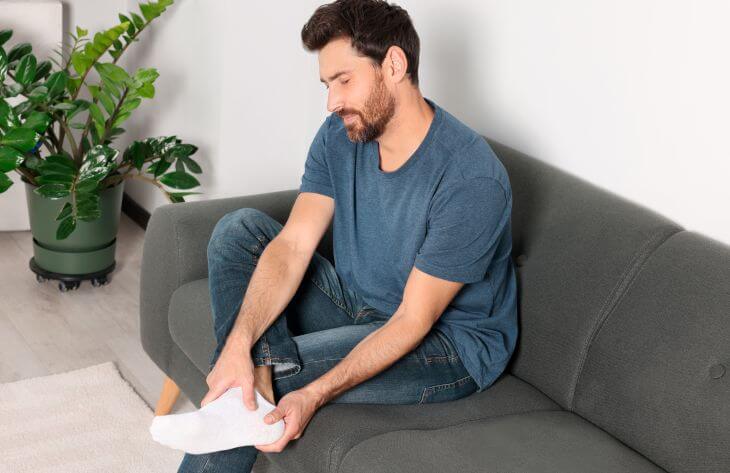What You Need to Know About Baxter’s Nerve Entrapment

Baxter’s nerve entrapment, also known as inferior calcaneal nerve entrapment or Baxter’s neuropathy, is a condition that affects the nerves in the heel and can cause pain and discomfort in the foot. If you have foot or ankle pain, you may be experiencing symptoms of Baxter’s nerve entrapment.
What Causes Baxter’s Nerve Entrapment?
The condition is caused by the compression or pinching of the nerve that runs along the bottom of the foot. The causes of Baxter’s nerve entrapment are not fully understood, but it is believed to be caused by a combination of factors, including poor foot biomechanics, repetitive stress, and injury.
People who participate in high-impact sports or activities that put a lot of stress on the feet, such as running or jumping, are at a higher risk of developing the condition. People who are overweight are also at higher risk of Baxter’s nerve compression.
Symptoms of Baxter’s Neuritis or Nerve Entrapment
The most common symptom of Baxter’s nerve entrapment is pain in the bottom of the foot. This pain is often described as a burning or shooting sensation and can be felt in the heel, arch, and ball of the foot. The pain may be intermittent or constant and can be aggravated by standing, walking, or running.
In addition to pain, Baxter’s nerve entrapment can also cause tingling or numbness in the bottom of the foot. This sensation is often described as a pins and needles feeling and can be felt in the toes, heel, and arch of the foot.
The tingling or numbness may also be accompanied by a loss of sensation, making it difficult to feel the ground beneath the foot. This can be alarming, especially when combined with other symptoms that affect foot movement and balance.
Another common symptom of Baxter’s nerve entrapment is weakness in the foot. This can make it difficult to stand on the affected foot or push off when walking or running. The weakness may also cause the foot to feel unstable or wobbly, making it more difficult to maintain balance.
If left untreated, Baxter’s nerve entrapment can lead to more severe symptoms, including a loss of muscle mass in the foot and ankle, as well as a decrease in range of motion. It is important to seek treatment as soon as possible if you are experiencing any of these symptoms.
Treatment for Baxter’s Nerve Entrapment
Treatment for Baxter’s nerve entrapment can include a variety of methods, depending on the severity of the condition. Some people may benefit from rest and ice to reduce inflammation and pain, while others may require more advanced treatments such as physical therapy, orthotics, or surgery.
Physical therapy can be an effective treatment for Baxter’s nerve entrapment, as it can help to strengthen the foot and improve biomechanics. Physical therapists can also provide massages and other techniques to help relieve pain and reduce inflammation.
Orthotics, or shoe inserts, can also be effective in treating Baxter’s nerve entrapment. These devices can help to redistribute pressure on the foot and provide support for the arch and heel. In some cases, custom orthotics may be necessary to address specific foot biomechanical issues.
Surgery may be necessary in severe cases of Baxter’s nerve entrapment. During surgery, the nerve is released from the surrounding tissues to relieve pressure and allow it to function normally. Surgery is typically only recommended when other treatments have failed or when the condition is causing significant pain and disability.
Baxter’s Nerve Entrapment Stretches
Baxter’s nerve entrapment stretches can help alleviate some of the symptoms. Here is a few Baxter’s nerve entrapment stretch options for symptom relief:
- Calf stretch. To perform this stretch, stand facing a wall with your hands on the wall at shoulder height. Place one foot behind the other and bend the front knee while keeping the back leg straight. Lean forward into the wall to feel a stretch in the back of the calf. Hold for 30 seconds and repeat on the other side.
- Plantar fascia stretches. Sit in a chair and cross one foot over the opposite knee. Use one hand to hold the toes of the crossed foot and use the other hand to pull the ankle towards your body. This will stretch the bottom of the foot. Hold for 30 seconds and repeat on the other side.
- Towel stretch. Sit on the floor with your legs straight out in front of you. Place a towel around the ball of your foot and hold the ends of the towel with both hands. Gently pull the towel towards your body to stretch the calf and the bottom of the foot. Hold for 30 seconds and repeat on the other side.
Preventing Baxter’s nerve entrapment involves reducing the risk of injury to the foot and practicing good foot care. This can include wearing supportive shoes that fit properly, avoiding high-impact activities that stress the feet, stretches and maintaining a healthy weight to reduce pressure on the feet.

Baxter’s nerve entrapment can be a painful and debilitating condition that can significantly impact a person’s quality of life. However, with proper treatment and prevention, it is possible to manage the symptoms and reduce the risk of recurrence.
If you are experiencing symptoms of Baxter’s nerve entrapment, it is important to seek medical attention to determine the best course of treatment for your individual needs.
The information provided on this website, including text, graphics, images, and other materials, is intended solely for informational purposes and should not be used as a substitute for professional medical advice, diagnosis, or treatment.


)